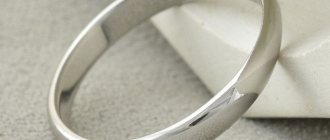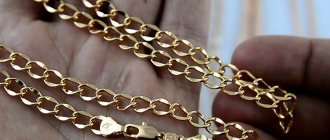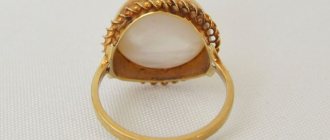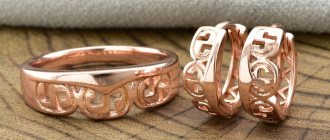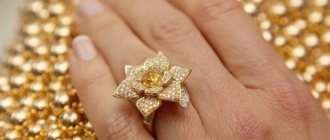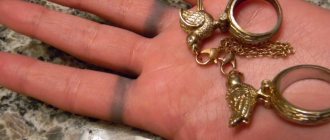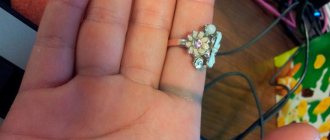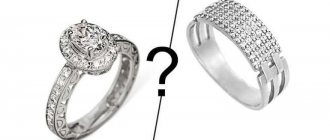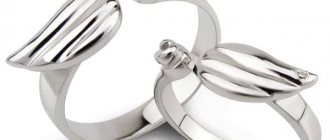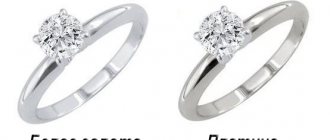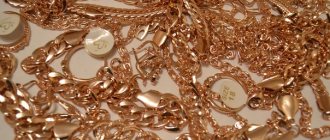For a very long time people have been familiar with the yellow metal with amazing properties. Is this gold. They worshiped him, prayed to him, went to war, killed him. Now gold is used as a means of accumulation and savings, making jewelry, and in industry.
In its pure form, gold is used for investment, but alloys with other metals have made it possible to create interesting compositions. In the process of alloying, rose gold, green, black, and white appeared. The latter is preferred by jewelers to create products from precious stones.
White gold shows the beauty of diamonds and brilliants better than other metals, their natural purity and depth. Platinum is added to regular gold to give it a white color. Just one tenth gives an amazing white color. Since platinum is a rather expensive and refractory metal, jewelers use manganese, nickel, and palladium. For its chemical and aesthetic properties, white gold is very popular all over the world. It is considered an alternative to boring yellow gold.
Alloy composition
Gold in its pure form always has a yellow tint, so you cannot get white without impurities. White gold is not a specific type, but an alloy that can have different compositions. Nickel, platinum and palladium give it its characteristic color. They can be found in different proportions - the price of the product will depend on this.
Some people assume that white gold comes from the addition of silver, but in reality it is added very rarely and in small proportions. It dulls the decoration and deprives it of shine, which is considered a negative characteristic.
The combination of different elements in an alloy is called a master alloy. The composition of the white gold alloy may include the following metals:
- platinum;
- palladium;
- zinc;
- nickel;
- silver;
- bronze and others.
The most expensive alloy is made with platinum and palladium - only well-off people can purchase jewelry from it. But there are other, cheaper varieties - for example, with silver and nickel. However, you should wear such jewelry with caution: nickel may cause an allergic reaction. If the skin in contact with the metal becomes inflamed and red, it is best to discard this product or purchase a more expensive equivalent.
One of the most popular variations of white gold is 585. It includes the traditional 58.5% pure gold, and the remaining elements are copper (no more than 34%) and silver (no more than 7.5%). This alloy is practical because, thanks to the high content of precious metals, it does not fade over time, and copper gives it additional strength, which allows you to use the jewelry for many years.
It is a favorite material and highly prized, so it is not surprising that it is associated with wealth and costliness, although it does not always command a high price. This is also indicated by the famous paraphrase: in a figurative sense, cotton is usually called white gold, showing its value and significance.
Customer Reviews
Sergey, 30 years old
I recently bought a white gold signet from hand, and today I discovered that it was a fake. When the jewelry fell on the tile, a dent appeared in the form of a chip; I took it to the jeweler and found out that it was 925 sterling silver plated with rhodium. Now in my life I will never buy jewelry secondhand and I don’t recommend it to anyone.
Tatyana, 25 years old
White gold is my favorite precious metal. For example, the quality of 585 standard is excellent, and the cost of the products suits me quite well, not to mention the many designer interpretations. I recommend.
Manufacturing process
White gold is made in two main ways. The more expensive alloy, obtained with the addition of platinum, does not require additional processing, so its manufacturing scheme is simple:
- In industrial conditions, pure gold is melted, which happens quickly, because its melting point is low.
- Then the ligature is prepared. Metals that will later be included in the alloy are carefully measured so that their content strictly corresponds to the standard. They are also melted and then mixed until a homogeneous mass is formed.
- The most difficult stage is the last one, where you need to mix the ligature and gold. In this case, all necessary conditions must be observed, otherwise the product will be of poor quality.
This is where the production of the expensive version ends, but with the cheap one everything is somewhat more complicated. It contains nickel, which not only can be an allergen, but also affects the color of the product in a negative way. Therefore, such jewelry is not produced in its natural form. As a rule, they are coated on top with rhodium, an extremely expensive metal that is part of the platinum group. This procedure is called rhodium plating.
After such treatment, the owner of the jewelry will not come into contact with nickel, but with rhodium, so allergies are excluded. Sometimes this metal is included in an alloy, then the coating is made of ruthenium, which is part of the same platinum group, but is more common and has a lower price.
However, rhodium-plated products have disadvantages, and the main one is the coating that gradually wears off. It is best not to wear them every day, putting them on only for the most special moments. This way the original look will last longer.
Various shades
Depending on the added metals and their proportions, white gold of different shades is obtained:
- to get the classic white color, an alloy of 14% palladium, 7% silver and 4% nickel is used, sometimes not irradiated;
- a high silver content - usually 25% - gives the product a green tint;
- to obtain an alloy with a yellow tint, 15% silver and 10% copper are added to it;
- a more saturated red color is given by a high copper content - 21% - with a lower proportion of silver - 4%;
- gold of an exotic bluish or black hue can be obtained using complex technological processes involving rhodium, which significantly increases the price of the final product.
There are a lot of variations, which allows you to combine them with various precious stones to create unique jewelry. However, the traditional white color is most valued.
Where can you buy or sell
In most cases, gold is purchased from jewelry stores or from a manufacturer. This protects us from counterfeits and is accompanied by a photo, a quality certificate and a guarantee. You can pay attention to pawn shops, where used jewelry is offered at discounted prices.
They sell through the same pawnshops, purchases, and jewelry workshops. They accept gold, preferring 585 purity, as scrap, by weight, often not taking into account precious stones. If you are the owner of a truly unique item, then you should pay attention to auctions. There you can sell your item at a significantly higher price.
Metal samples
When talking about the quality of jewelry, the standard of the metal from which it is made is usually mentioned, but not everyone understands what exactly this term means. The hallmark (or hallmark) shows the gold content of the alloy. The most common is 585, which contains 58.5% gold.
Since all high-quality products have a certain standard, it is easy to guess that nothing can be made from pure gold without impurities. This is true: although this metal is popular and highly valued, it is not so easy to work with. It is too soft and pliable and easily deformed even in everyday conditions. Therefore, jewelry made from it in its pure form would be fragile and short-lived.
There are many samples of gold , but here are the most famous ones, which are easy to find for sale in any jewelry store:
- 375 - due to the low content of gold itself (37.5%), products on which this sample is applied are considered the least valuable. They usually contain a considerable proportion of nickel, which can cause certain problems. There are other varieties of 375 standard, which use an alloy made of more precious metals. A definite advantage of such jewelry is their price: they are accessible to almost all segments of the population.
- 500 is a rare standard in which the gold part is exactly half. It is not often used for several reasons. Firstly, the high proportions of silver and copper included in the composition give the alloy shades that are not very pleasing to the eye. Secondly, the very structure of the material is such that it is difficult to work with. It will most likely not be possible to cast something cute and elegant out of it.
- 585 is the most commonly used grade with 58.5% gold. It has become so widespread due to the successful combination of a pleasant appearance and the possibility of long-term use.
- 750 is the highest standard for white gold and, accordingly, the most expensive. It contains 75% pure aurum, which makes such jewelry particularly fragile and vulnerable to any external influences. Those who acquire them should remember that they require careful care. This alloy is very highly valued and therefore is found in the collections of famous jewelry manufacturers: Bulgari, Tiffany and others.
How many carats are in this sample?
Some countries do not use the European system, but measure the purity of gold in carats. In terms of “karatej” (or carat) it meets our standards and looks like this:
| Try | Carat |
| 375 | 9 (England, Canada and some others) |
| 417 | 10 |
| 583 (585) | 14 |
| 750 | 18 |
| 833 | 20 (Asia) |
| 999 (1000) | 24 (pure gold) |
The minimum number of carats for an item to be considered gold varies by country. So, in the USA, 10 carats is the minimum acceptable standard. In Austria, Portugal and Ireland it is lower and can be equal to 9.
14 carats, strictly speaking, equals 583 fineness. But since the carat calculation does not provide for the 585th fineness, it was decided to round this value.
How to spot a fake
When purchasing expensive jewelry, you always want to be sure that white gold is the real material and not a cheap imitation. There are several simple ways to check what elements a piece of jewelry is made of.
The first thing to do is check the hallmark to see if it is present and looks right. However, this method is not the most effective these days, when it is not so difficult to fake markings. Even if it exists, it could well have been stamped using special equipment.
To understand whether sellers are selling cheaper silver for white gold, you need to take a closer look at it. Despite the admixtures of metals with cold undertones, the color of gold will still be overall warm. If nothing of the kind is noticeable and only cool shades are visible in the color scheme, most likely it is silver.
There is a more reliable way to check: run the product across a sheet of white paper. Silver jewelry will leave a noticeable mark on it, while gold jewelry will leave the sheet clean.
Another simple way to distinguish fake gold from real gold is to buy a lapis pencil at the pharmacy, moisten it in water and run it over the metal. If the alloy is genuine, there will be no traces left on it.
Real gold jewelry can be placed in vinegar for a while and it will not change in appearance, which cannot be said about a fake - its color will change.
Another chemical reaction that can be easily done at home requires the use of iodine. You need to drop a minimal amount of this substance onto the surface of the gold and wipe it off immediately. If the jewelry is genuine, it will look the same as before, but a small mark will remain on the fake one.
Finally, a method that does not always work in the modern world involves using a magnet. Precious metals are not attracted to it, so a reaction to it means there is an impurity in the composition. However, nickel, which is quite often used to create the alloy, reacts to a magnet. But still, its percentage is usually low, and the product should not be attracted quickly and strongly. If this happens, it is highly likely to be a fake.
How to distinguish white gold from silver?
These two precious metals are very similar in appearance, but silver is much cheaper than white gold, in addition, silver is only a ligature for expensive white gold. How to recognize silver?
First of all, you should pay attention to the standard: gold jewelry uses 585 or 750 standard, silver 925. White gold has a brighter shine than silver. In addition, it is harder than silver.
What difficulties will the owner of white gold have to face?
The capricious alloy of white gold must be carefully monitored: periodically take the product to a jeweler in order to correct the rhodium layer, if any. White gold can become damaged during everyday wear if it comes into contact with harsh chemicals or if it comes into frequent contact with tap water, which may contain bleach.
Advantages and disadvantages
Whether it is worth buying products made from this metal and why, everyone will decide for themselves. But it is still necessary to note some features that can influence the choice in one direction or another.
Products made from precious metals delight their owners with unique properties that allow them to wear such jewelry for many years and even pass it on from generation to generation. If the alloy contains platinum, the advantages of use will be felt especially well, since both this metal and gold do not react with alkalis and acids. Thanks to this, the item will last a long time and will be slightly susceptible to corrosion.
In addition, this combination of metals has high strength and wear resistance. The owner will have little chance of scratching the jewelry , breaking off a piece from it, or otherwise mechanically damaging it. Water and air, which constantly affect jewelry, will also not have a significant effect on the condition of the jewelry.
But there are also disadvantages that you should remember when choosing. When buying a variation containing platinum, you will have to spend a lot of money, because such an alloy is even more expensive than regular gold. It is best to purchase such things in specialized jewelry stores designed for respectable clients, so as not to stumble upon a fake.
If the choice fell on a less expensive rhodium-plated product, it is worth remembering that the outer layer will thin out over time, and the type of decoration will change. This coating can always be updated by contacting a jeweler, but this will cost additional money.
Features of jewelry
White gold is a raw material from which any type of jewelry can be made. The alloy, which contains nickel, is used as a raw material for the manufacture of brooches, rings and pendants. Such jewelry is durable, but they still have one significant drawback - nickel does not “bleach” aurum well, so the resulting alloy has a yellowish tint. However, jewelry craftsmen have learned to cope with this problem by applying a thin layer of rhodium to the jewelry, which gives the accessories not only aesthetic appeal, but also durability. It is worth considering that over time, the rhodium coating wears out, and the owner of jewelry with such coating has to contact the master once every 5-7 years and pay money for the service of updating the rhodium layer.
If white gold contains platinum or palladium, then it does not need additional “whitening”, since the alloy is already incredibly beautiful and wear-resistant. Raw material combining aurum, silver, palladium or platinum is used as a material for the manufacture of fixatives (mounts) for precious stones. The strength of the alloy ensures reliable attachment of stones to the product, but this is not the only advantage of white aurum. Metal with a steel tint emphasizes the radiance and purity of precious stones, regardless of their color scheme. Still, the most popular white gold jewelry is considered to be those set with diamonds.
In many jewelry stores you can be impressed by the rich selection of models of magnificent bracelets, rings, rings, earrings, pendants, pendants, chains and wedding rings made from this aurum alloy. Jewelry in which white gold is combined with other alloys of the precious metal looks especially respectable.
Caring for such products is not difficult, but it is important to avoid the use of substances that can spoil the appearance of white gold. First of all, this applies to products coated with rhodium. The coating wears out over time under the influence of mechanical factors, so it is recommended to protect products from scratches, contact with other metals, etc. In order for jewelry to retain its ideal appearance for a long time, it is important to avoid exposure to cosmetics, aggressive household chemicals and acids. It is enough to wash accessories once a month in soapy water or rub them with suede (or microfiber).
You need to be especially careful with jewelry containing precious stones. Improper care of such products can hopelessly damage them or lead to them falling out of the frame. It is recommended to entrust the care of especially valuable jewelry to a professional.
Use Cases
White metal is so popular precisely because it has virtually no restrictions on its use. Jewelry made from it can be of any size and shape and still look great.
Earrings, rings, bracelets, necklaces, chains and other accessories of any complexity are made from it. It goes well with any precious stones, but diamonds or moonstone look especially elegant when framed with it.
Both men and women of any age can wear such jewelry. It is also suitable for small children who are just beginning to form their preferences. And if some more traditional options - for example, gold in the usual yellow shade - may become outdated over time , then the stylish white color will never go out of fashion.
Care and cleaning rules
The habit of washing dishes or swimming in chlorinated pool water without removing jewelry can have a detrimental effect on its appearance over time. Despite the wear resistance of white gold, under constant exposure to detergents it can tarnish and change color to a dirty gray. The easiest way is to go to a jewelry workshop, where the jewelry will be polished again or the rhodium plating will be renewed.
However, you can clean them yourself at home. To do this, you need to prepare a solution of ammonia and creamy soap, foam it and put the jewelry there for several hours. After this, without rinsing with water, wipe dry with a velvet cloth. Under no circumstances should items containing precious stones be immersed in such a solution. It is necessary to apply a mixture of ammonia and soap to a sponge or microfiber cloth and thoroughly wipe the metal surface without touching the stones or pearls. Leave it like this for an hour, rinse in clean water and polish with a dry cloth.
If you know that the composition contains a large percentage of silver, then you can apply toothpaste to the metal, leave it overnight, and in the morning rinse and wipe dry. But you don’t have to worry about cracks and scratches - they simply cannot appear on such a durable alloy, regardless of the presence of affordable nickel or expensive platinum.
